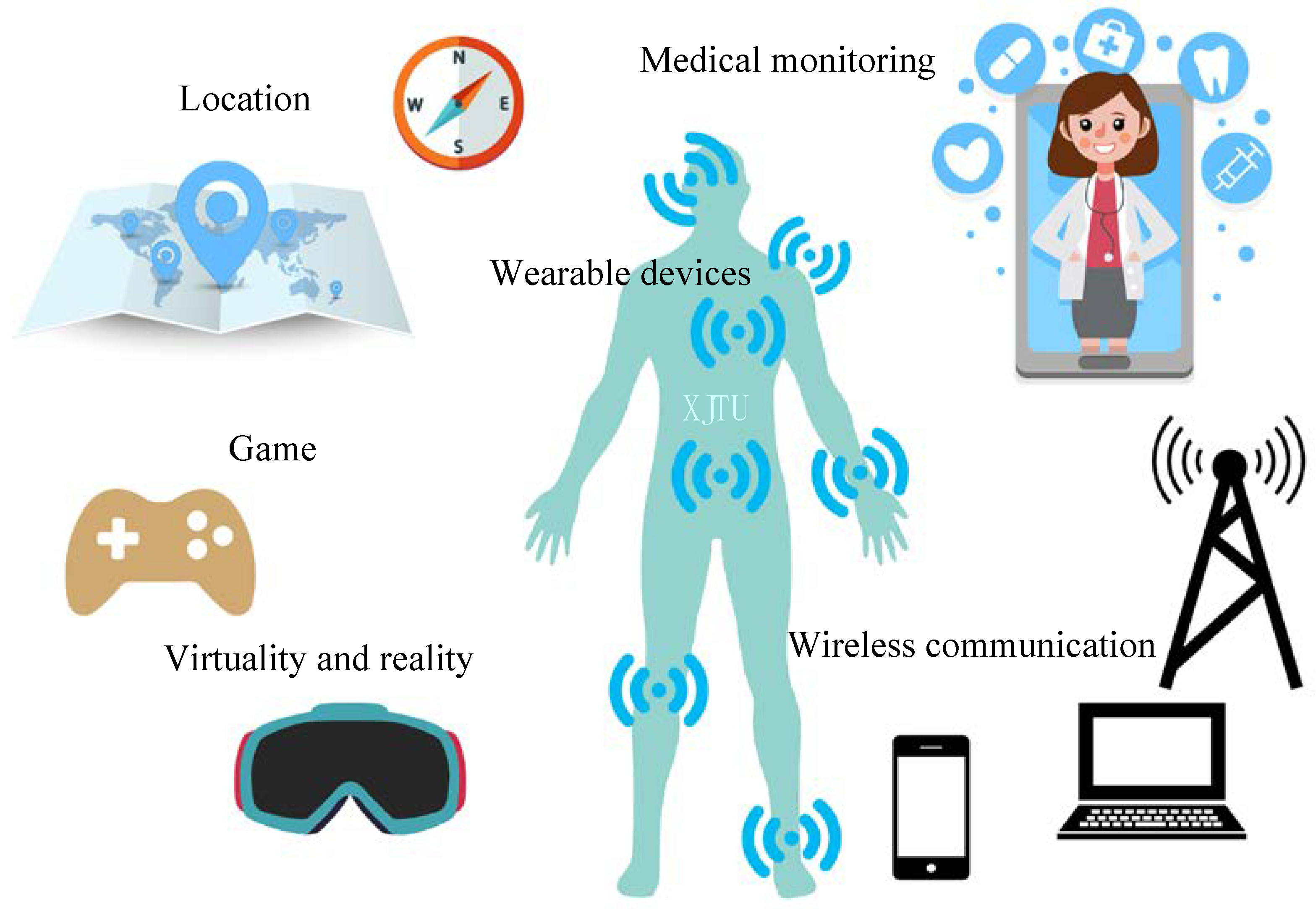Meta-Wearable Antennas—A Review of Metamaterial Based Antennas in Wireless Body Area Networks
Abstract
:1. Introduction
2. Wearable Antennas Based on Composite Right/Left-Handed Transmission Lines (CRLH TLs)
2.1. Wearable Electrical Small Antennas (ESAs) Based on Zeroth-Order Resonance (ZOR)
2.2. Wearable Dual-Band Patch Antennas Based on CRLH TLs
3. Wearable Antennas Based on Metasurfaces
3.1. Single-Band Wearable Antennas with Metasurfaces
3.2. Dual-Band Wearable Antennas with Metasurfaces
- A dual-band antenna is first designed in the two frequency bands of interest.
- An AMC is designed to operate within the same two bands as the antenna.
- The AMC is integrated with the antenna and is optimized further in simulations via parametric study.
- The optimized structure is fabricated and measured.
4. Reconfigurable Wearable Antennas with Metamaterials
5. Conclusions
- The radiation properties of wearable antennas can be enhanced by restraining the surface wave and the coupling between antennas and the human body.
- A low-profile of a wearable antenna can be realized by using the zero-reflection phase available from metasurfaces such as AMC structures.
- The bandwidth of wearable antennas can be broadened by loading reactive metasurfaces.
- The direction of radiation and level of gain can be controlled by modification of the field distributions and propagation directions.
Author Contributions
Funding
Conflicts of Interest
References
- Bariya, M.; Nyein, H.Y.Y.; Javey, A. Wearable sweat sensors. Nat. Electron. 2018, 1, 160–171. [Google Scholar] [CrossRef]
- Januszkiewicz, Ł.; Di Barba, P.; Hausman, S. Optimal Design of Switchable Wearable Antenna Array for Wireless Sensor Networks. Sensors 2020, 20, 2795. [Google Scholar] [CrossRef] [PubMed]
- El Gharbi, M.; Fernández-García, R.; Ahyoud, S.; Gil, I. A Review of Flexible Wearable Antenna Sensors: Design, Fabrication Methods, and Applications. Materials 2020, 13, 3781. [Google Scholar] [CrossRef] [PubMed]
- Abd Rahman, N.H.; Yamada, Y.; Amin Nordin, M.S. Analysis on the Effects of the Human Body on the Performance of Electro-Textile Antennas for Wearable Monitoring and Tracking Application. Materials 2019, 12, 1636. [Google Scholar] [CrossRef] [PubMed] [Green Version]
- Zhang, K.; Vandenbosch, G.A.E.; Yan, S. A Novel Design Approach for Compact Wearable Antennas Based on Metasurfaces. IEEE Trans. Biomed. Circuits Syst. 2020, 14, 918–927. [Google Scholar] [CrossRef] [PubMed]
- Smida, A.; Iqbal, A.; Alazemi, A.J.; Waly, M.I.; Ghayoula, R.; Kim, S. Wideband Wearable Antenna for Biomedical Telemetry Applications. IEEE Access 2020, 8, 15687–15694. [Google Scholar] [CrossRef]
- Tian, X.; Lee, P.M.; Tan, Y.J.; Wu, T.L.Y.; Yao, H.C.; Zhang, M.Y.; Li, Z.P.; Ng, K.A.; Tee, B.C.K.; Ho, J.S. Wireless body sensor networks based on metamaterial textiles. Nat. Electron. 2019, 2, 243–251. [Google Scholar] [CrossRef]
- Abdi, A.; Ghorbani, F.; Aliakbarian, H.; Geok, T.K.; Rahim, S.K.A.; Soh, P.J. Electrically Small Spiral PIFA for Deep Implantable Devices. IEEE Access 2020, 8, 158459–158474. [Google Scholar] [CrossRef]
- Alqadami, A.S.M.; Bialkowski, K.S.; Mobashsher, A.T.; Abbosh, A.M. Wearable Electromagnetic Head Imaging System Using Flexible Wideband Antenna Array Based on Polymer Technology for Brain Stroke Diagnosis. IEEE Trans. Biomed Circuits Syst. 2019, 13, 124–134. [Google Scholar] [CrossRef]
- Harun Al Rasyid, M.U.; Lee, B.H.; Sudarsono, A. Wireless body area network for monitoring body temperature, heart beat and oxygen in blood. In Proceedings of the Intelligent Technology and Its Applications (ISITIA), Surabaya, Indonesia, 20–21 May 2015; pp. 95–98. [Google Scholar]
- Singh, M.; Jain, N. Performance and Evaluation of Smartphone Based Wireless Blood Pressure Monitoring System Using Bluetooth. IEEE Sens. J. 2016, 16, 8322–8328. [Google Scholar] [CrossRef]
- Hong, S.; Kang, S.H.; Kim, Y.; Jung, C.W. Transparent and Flexible Antenna for Wearable Glasses Applications. IEEE Trans. Antennas Propag. 2016, 64, 2797–2804. [Google Scholar] [CrossRef]
- Qu, L.; Zhang, R.; Kim, H. High-Sensitivity Ground Radiation Antenna System Using an Adjacent Slot for Bluetooth Headsets. IEEE Trans. Antennas Propag. 2015, 63, 5903–5907. [Google Scholar] [CrossRef]
- Lee, H.; Yang, H.; Myeong, S.; Lee, K. Dual-band MNG patch antenna for smart helmet. Electron. Lett. 2018, 54, 1101–1102. [Google Scholar] [CrossRef]
- Alqadami, A.S.M.; Trakic, A.; Stancombe, A.E.; Mohammed, B.; Bialkowski, K.; Abbosh, A. Flexible Electromagnetic Cap for Head Imaging. IEEE Trans. Biomed. Circuits Syst. 2020, 14, 1097–1107. [Google Scholar] [CrossRef] [PubMed]
- Chen, Y.S.; Ku, T.Y. A Low-Profile Wearable Antenna Using a Miniature High Impedance Surface for Smartwatch Applications. IEEE Antennas Wirel. Propag. Lett. 2016, 15, 1144–1147. [Google Scholar] [CrossRef]
- Gao, G.P.; Hu, B.; Wang, S.F.; Yang, C. Wearable Circular Ring Slot Antenna with EBG Structure for Wireless Body Area Network. IEEE Antennas Wirel. Propag. Lett. 2018, 17, 434–437. [Google Scholar] [CrossRef]
- Stoppa, M.; Chiolerio, A. Wearable Electronics and Smart Textiles: A Critical Review. Sensors 2014, 14, 11957–11992. [Google Scholar] [CrossRef] [Green Version]
- Almohammed, B.; Alyani, I.; Aduwati, S. Electro-textile wearable antennas in wireless body area networks: Materials, antenna design, manufacturing techniques, and human body consideration—A review. Textile Res. J. 2020. [Google Scholar] [CrossRef]
- Paracha, K.N.; Rahim, S.K.A.; Soh, P.J.; Kamarudin, M.R.; Tan, K.G.; Lo, Y.C.; Islam, M.T. A Low Profile, Dual-band, Dual Polarized Antenna for Indoor/Outdoor Wearable Application. IEEE Access 2019, 7, 33277–33288. [Google Scholar] [CrossRef]
- Simorangkir, R.B.V.B.; Kiourti, A.; Esselle, K.P. UWB Wearable Antenna with a Full Ground Plane Based on PDMS-Embedded Conductive Fabric. IEEE Antennas Wirel. Propag. Lett. 2018, 17, 493–496. [Google Scholar] [CrossRef]
- Sayem, A.M.; Simorangkir, R.B.V.B.; Esselle, K.P.; Hashmi, R.M.; Liu, H.R. A Method to Develop Flexible Robust Optically Transparent Unidirectional Antennas Utilizing Pure Water, PDMS, and Transparent Conductive Mesh. IEEE Trans. Antennas Propag. 2020, 68, 6943–6952. [Google Scholar] [CrossRef]
- Zhang, J.H.; Yan, S.; Vandenbosch, G.A.E. A Miniature Feeding Network for Aperture-Coupled Wearable Antennas. IEEE Trans. Antennas Propag. 2017, 65, 2650–2654. [Google Scholar] [CrossRef]
- Myny, K. The development of flexible integrated circuits based on thin-film transistors. Nat. Electron. 2018, 1, 30–39. [Google Scholar] [CrossRef]
- Yan, S.; Soh, P.J.; Vandenbosch, G.A.E. Wearable Ultrawideband Technology—A Review of Ultrawideband Antennas, Propagation Channels, and Applications in Wireless Body Area Networks. IEEE Access 2018, 6, 42177–42185. [Google Scholar] [CrossRef]
- Poffelie, L.A.Y.; Soh, P.J.; Yan, S.; Vandenbosch, G.A.E. A High-Fidelity All-Textile UWB Antenna with Low Back Radiation for Off-Body WBAN Applications. IEEE Trans. Antennas Propag. 2016, 64, 757–760. [Google Scholar] [CrossRef]
- Yoon, J.; Jeong, Y.; Kim, H.; Yoo, S.; Jung, H.S.; Kim, Y.; Hwang, Y.; Hyun, Y.; Hong, W.K.; Lee, B.H.; et al. Robust and stretchable indium gallium zinc oxide-based electronic textiles formed by cilia-assisted transfer printing. Nat. Commun. 2016, 7, 11477. [Google Scholar] [CrossRef] [PubMed] [Green Version]
- Yan, S.; Volskiy, V.; Vandenbosch, G.A.E. Compact Dual-Band Textile PIFA for 433-MHz/2.4-GHz ISM Bands. IEEE Antennas Wirel. Propag. Lett. 2017, 16, 2436–2439. [Google Scholar] [CrossRef]
- Hu, X.M.; Sen, Y.; Vandenbosch, G.A.E. Wearable Button Antenna for Dual-Band WLAN Applications with Combined on and off-Body Radiation Patterns. IEEE Trans. Antennas Propag. 2017, 65, 1384–1387. [Google Scholar]
- Carey, T.; Cacovich, S.; Divitini, G.; Ren, J.S.; Mansouri, A.; Kim, J.M.; Wang, C.X.; Ducati, C.; Sordan, R.; Torrisi, F. Fully inkjet-printed two-dimensional material field-effect heterojunctions for wearable and textile electronics. Nat. Commun. 2017, 8, 1202. [Google Scholar] [CrossRef] [Green Version]
- Genovesi, S.; Costa, F.; Fanciulli, F.; Monorchio, A. Wearable Inkjet-Printed Wideband Antenna by Using Miniaturized AMC for Sub-GHz Applications. IEEE Antennas Wirel. Propag. Lett. 2016, 15, 1927–1930. [Google Scholar] [CrossRef]
- Hao, J.; Leblanc, A.; Burgnies, L.; Djouadi, A.; Cochrane, C.; Rault, F.; Koncar, V.; Lheurette, E. Textile split ring resonator antenna integrated by embroidery. Electron. Lett. 2019, 55, 508–509. [Google Scholar] [CrossRef] [Green Version]
- Quarfoth, R.; Zhou, Y.S.; Sievenpiper, D. Flexible Patch Antennas Using Patterned Metal Sheets on Silicone. IEEE Antennas Wirel. Propag. Lett. 2015, 14, 1354–1357. [Google Scholar] [CrossRef]
- Yan, S.; Soh, P.J.; Vandenbosch, G.A.E. Dual-Band Textile MIMO Antenna Based on Substrate-Integrated Waveguide (SIW) Technology. IEEE Trans. Antennas Propag. 2015, 63, 4640–4647. [Google Scholar] [CrossRef]
- Yan, S.; Soh, P.J.; Vandenbosch, G.A.E. Wearable Dual-Band Magneto-Electric Dipole Antenna for WBAN/WLAN Applications. IEEE Trans. Antennas Propag. 2015, 63, 4165–4169. [Google Scholar] [CrossRef]
- Chen, J.; Berg, M.; Somero, V.; Amin, H.Y.; Prssinen, A. A Multiple Antenna System Design for Wearable Device Using Theory of Characteristic Mode. In Proceedings of the 12th European Conference on Antennas and Propagation, London, UK, 9–13 April 2018; pp. 1–5. [Google Scholar]
- Elias, B.B.Q.; Soh, P.J.; Al-Hadi, A.A.; Vandenbosch, G.A.E. Design of a compact, wideband, and flexible rhombic antenna using CMA for WBAN/WLAN and 5G applications. Int. J. Numer. Model. Electron. Netw. Devices Fields 2020, e2841. [Google Scholar] [CrossRef]
- Yue, T.W.; Jiang, Z.H.; Werner, D.H. Compact, Wideband Antennas Enabled by Interdigitated Capacitor-Loaded Metasurfaces. IEEE Trans. Antennas Propag. 2016, 64, 1595–1606. [Google Scholar] [CrossRef]
- Le, T.T.; Yun, T.Y. Miniaturization of a Dual-Band Wearable Antenna for WBAN Applications. IEEE Antennas Wirel. Propag. Lett. 2020, 19, 1452–1456. [Google Scholar] [CrossRef]
- Yue, T.W.; Jiang, Z.H.; Werner, D.H. A Compact Metasurface-Enabled Dual-Band Dual-Circularly Polarized Antenna Loaded With Complementary Split Ring Resonators. IEEE Trans. Antennas Propag. 2019, 67, 794–803. [Google Scholar] [CrossRef]
- Maleszka, T.; Pawel, K. Bandwidth properties of embroidered loop antenna for wearable applications. In Proceedings of the 3rd European Wireless Technology Conference, Paris, France, 27–28 September 2010. [Google Scholar]
- Casula, G.A.; Montisci, G. A Design Rule to Reduce the Human Body Effect on Wearable PIFA Antennas. Electronics 2019, 8, 244. [Google Scholar] [CrossRef] [Green Version]
- Gao, G.P.; Yang, C.; Hu, B.; Zhang, R.F.; Wang, S.F. A Wide-Bandwidth Wearable All-Textile PIFA with Dual Resonance Modes for 5 GHz WLAN Applications. IEEE Trans. Antennas Propag. 2019, 67, 4206–4211. [Google Scholar] [CrossRef]
- Caloz, C.; Itoh, T. Electromagnetic Metamaterials: Transmission Line Theory and Microwave Applications; Wiley: Hoboken, NJ, USA, 2005. [Google Scholar]
- Lai, A.; Caloz, C.; Itoh, T. Composite right/left-handed transmission line metamaterials. IEEE Microw. Mag. 2004, 5, 34–50. [Google Scholar] [CrossRef]
- Sanada, A.; Caloz, C.; Itoh, T. Characteristics of the composite right/left-handed transmission lines. IEEE Antennas Wirel. Propag. Lett. 2004, 14, 68–70. [Google Scholar] [CrossRef]
- Sun, K.P.; Han, S.; Choi, J.H.; Lee, J.K. Miniaturized Active Metamaterial Resonant Antenna with Improved Radiation Performance Based on Negative-Resistance-Enhanced CRLH Transmission Lines. IEEE Antennas Wirel. Propag. Lett. 2018, 17, 1162–1165. [Google Scholar] [CrossRef]
- Ahdi Rezaeieh, S.; Antoniades, M.A.; Abbosh, A.M. Bandwidth and Directivity Enhancement of Loop Antenna by Nonperiodic Distribution of Mu-Negative Metamaterial Unit Cells. IEEE Trans. Antennas Propag. 2016, 64, 3319–3329. [Google Scholar] [CrossRef]
- Ahdi Rezaeieh, S.; Antoniades, M.A.; Abbosh, A.M. Miniaturization of Planar Yagi Antennas Using Mu-Negative Metamaterial-Loaded Reflector. IEEE Trans. Antennas Propag. 2017, 65, 6827–6837. [Google Scholar] [CrossRef]
- Park, B.; Lee, J. Circularly Polarized Antenna Based on Mu-Negative Transmission Line. In Proceedings of the 8th European Conference on Antennas Propagation, (EuCAP 2014), The Hague, The Netherlands, 6–11 April 2014; pp. 939–941. [Google Scholar]
- Ahdi Rezaeieh, S.; Antoniades, M.A.; Abbosh, A.M. Compact Wideband Loop Antenna Partially Loaded With Mu-Negative Metamaterial Unit Cells for Directivity Enhancement. IEEE Antennas Wirel. Propag. Lett. 2016, 15, 1893–1896. [Google Scholar] [CrossRef]
- Jae-Hyun, P.; Young-Ho, R.; Jeong-Hae, L. Mu-Zero Resonance Antenna. IEEE Trans. Antennas Propag. 2010, 58, 1865–1875. [Google Scholar] [CrossRef]
- Li, L.; Jia, Z.; Huo, F.F.; Han, W.Q. A Novel Compact Multiband Antenna Employing Dual-Band CRLH-TL for Smart Mobile Phone Application. IEEE Antennas Wirel. Propag. Lett. 2013, 12, 1688–1691. [Google Scholar] [CrossRef]
- Lee, H.M. A Compact Zeroth-Order Resonant Antenna Employing Novel Composite Right/Left-Handed Transmission-Line Unit-Cells Structure. IEEE Antennas Wirel. Propag. Lett. 2011, 10, 1377–1380. [Google Scholar]
- Xiong, J.; Lin, X.Q.; Yu, Y.F.; Tang, M.C.; Xiao, S.Q.; Wang, B.Z. Novel Flexible Dual-Frequency Broadside Radiating Rectangular Patch Antennas Based on Complementary Planar ENZ or MNZ Metamaterials. IEEE Trans. Antennas Propag. 2012, 60, 3958–3961. [Google Scholar] [CrossRef]
- Park, J.-H.; Ryu, Y.-H.; Lee, J.-G.; Lee, J.-H. Epsilon Negative Zeroth-Order Resonator Antenna. IEEE Trans. Antennas Propag. 2007, 55, 3710–3712. [Google Scholar] [CrossRef]
- Yan, S.; Soh, P.J.; Vandenbosch, G.A.E. Compact All-Textile Dual-Band Antenna Loaded With Metamaterial-Inspired Structure. IEEE Antennas Wirel. Propag. Lett. 2015, 14, 1486–1489. [Google Scholar] [CrossRef]
- Yan, S.; Soh, P.J.; Vandenbosch, G.A.E. Wearable dual-band composite right/left-handed waveguide textile antenna for WLAN applications. Electron. Lett. 2014, 50, 424–426. [Google Scholar] [CrossRef]
- Saleem, M.; Li, X.-L. Low Scattering Microstrip Antenna Based on Broadband Artificial Magnetic Conductor Structure. Materials 2020, 13, 750. [Google Scholar] [CrossRef] [PubMed] [Green Version]
- Cook, B.S.; Shamim, A. Utilizing Wideband AMC Structures for High-Gain Inkjet-Printed Antennas on Lossy Paper Substrate. IEEE Antennas Wirel. Propag. Lett. 2013, 12, 76–79. [Google Scholar] [CrossRef]
- Raad, H.R.; Abbosh, A.I.; Al-Rizzo, H.M.; Rucker, D.G. Flexible and Compact AMC Based Antenna for Telemedicine Applications. IEEE Trans. Antennas Propag. 2013, 61, 524–531. [Google Scholar] [CrossRef]
- Ashyap, A.Y.I.; Abidin, Z.Z.; Dahlan, S.H.; Majid, H.A.; Shah, S.M.; Kamarudin, M.R.; Alomainy, A. Compact and Low-Profile Textile EBG-Based Antenna for Wearable Medical Applications. IEEE Antennas Wirel. Propag. Lett. 2017, 16, 2550–2553. [Google Scholar] [CrossRef] [Green Version]
- Abirami, B.S.; Sundarsingh, E.F. EBG-Backed Flexible Printed Yagi–Uda Antenna for On-Body Communication. IEEE Trans. Antennas Propag. 2017, 65, 3762–3765. [Google Scholar] [CrossRef]
- Abbasi, M.A.B.; Nikolaou, S.; Antoniades, M.A.; Stevanovic, M.N.; Vryonides, P. Compact EBG-Backed Planar Monopole for BAN Wearable Applications. IEEE Trans. Antennas Propag. 2017, 65, 453–463. [Google Scholar] [CrossRef] [Green Version]
- El Atrash, M.; Abdalgalil, O.F.; Mahmoud, I.S.; Abdalla, M.A.; Zahran, S.R. Wearable high gain low SAR antenna loaded with backed all-textile EBG for WBAN applications. IET Microw. Antennas Propag. 2020, 14, 791–799. [Google Scholar] [CrossRef]
- Ali Esmail, B.; Majid, H.A.; Zainal Abidin, Z.; Haimi Dahlan, S.; Himdi, M.; Dewan, R.; Kamal, A.; Rahim, M.; Al-Fadhali, N. Reconfigurable Radiation Pattern of Planar Antenna Using Metamaterial for 5G Applications. Materials 2020, 13, 582. [Google Scholar] [CrossRef] [Green Version]
- Wang, L.B.; See, K.Y.; Zhang, J.W.; Salam, B.; Lu, A.C.W. Ultrathin and Flexible Screen-Printed Metasurfaces for EMI Shielding Applications. IEEE Trans. Electromagn. Compat. 2011, 53, 700–705. [Google Scholar] [CrossRef]
- Gajibo, M.M.; Rahim, M.K.A.; Bala, B.D. Reconfigurable epsilon negative metamaterial antenna. In Proceedings of the 2014 IEEE Asia-Pacific Conference on Applied Electromagnetics (APACE), Johor Bahru, Malaysia, 8–10 December 2014; pp. 265–267. [Google Scholar]
- Senior, D.E.; Yoon, Y. Dual Band Antenna Using the Substrate Integrated Waveguide As An Epsilon Negative Transmission Line. In Proceedings of the 2012 IEEE International Symposium on Antennas Propagation, Chicago, IL, USA, 8–14 July 2012; pp. 1–2. [Google Scholar]
- Das, G.K.; Basu, S.; Mandal, B.; Mitra, D.; Augustine, R.; Mitra, M. Gain-enhancement technique for wearable patch antenna using grounded metamaterial. IET Microw. Antennas Propag. 2020, 14, 2045–2052. [Google Scholar] [CrossRef]
- Cao, Y.F.; Cai, Y.; Cao, W.Q.; Xi, B.K.; Qian, Z.P.; Wu, T.; Zhu, L. Broadband and High-Gain Microstrip Patch Antenna Loaded With Parasitic Mushroom-Type Structure. IEEE Antennas Wirel. Propag. Lett. 2019, 18, 1405–1409. [Google Scholar] [CrossRef]
- Jang, S.; Lee, B. Meta-Structured One-Unit-Cell Epsilon Negative Antenna. Microw. Opt. Technol. Lett. 2009, 51, 2991–2994. [Google Scholar] [CrossRef]
- Alu, A.; Engheta, N. Pairing an epsilon-negative slab with a mu-negative slab: Resonance, tunneling and transparency. IEEE Trans. Antennas Propag. 2003, 51, 2558–2571. [Google Scholar] [CrossRef] [Green Version]
- Wen, D.L.; Hao, Y.; Munoz, M.O.; Wang, H.Y.; Zhou, H. A Compact and Low-Profile MIMO Antenna Using a Miniature Circular High-Impedance Surface for Wearable Applications. IEEE Trans. Antennas Propag. 2018, 66, 96–104. [Google Scholar] [CrossRef]
- Gao, G.P.; Zhang, R.F.; Geng, W.F.; Meng, H.J.; Hu, B. Characteristic Mode Analysis of a Nonuniform Metasurface Antenna for Wearable Applications. IEEE Antennas Wirel. Propag. Lett. 2020, 19, 1355–1359. [Google Scholar] [CrossRef]
- Pei, R.; Leach, M.P.; Lim, E.G.; Wang, Z.; Song, C.Y.; Wang, J.C.; Zhang, W.Z.; Jiang, Z.Z.; Huang, Y. Wearable EBG-Backed Belt Antenna for Smart On-Body Applications. IEEE Trans. Ind. Inform. 2020, 16, 7177–7189. [Google Scholar] [CrossRef]
- Cheng, X.Y.; Senior, D.E.; Kim, C.; Yoon, Y.K. A Compact Omnidirectional Self-Packaged Patch Antenna with Complementary Split-Ring Resonator Loading for Wireless Endoscope Applications. IEEE Antennas Wirel. Propag. Lett. 2011, 10, 1532–1535. [Google Scholar] [CrossRef]
- Yoon Geon, K.; Wonbin, H. Radiation Efficiency-Improvement Using a Via-Less, Planar ZOR Antenna for Wireless ECG Sensors on a Lossy Medium. IEEE Antennas Wirel. Propag. Lett. 2014, 13, 1211–1214. [Google Scholar] [CrossRef]
- Jung, T.J.; Kwon, J.H.; Lim, S. Flexible zeroth-order resonant antenna independent of substrate deformation. Electron. Lett. 2010, 46, 740–742. [Google Scholar] [CrossRef]
- Lee, J.; Kwak, S.I.; Lim, S. Wrist-wearable zeroth-order resonant antenna for wireless body area network applications. Electron. Lett. 2011, 47, 431–433. [Google Scholar] [CrossRef]
- FCC. Available online: https://www.fcc.gov/consumers/guides/wireless-devices-and-health-concerns (accessed on 21 December 2020).
- Review of Published Literature between 2008 and 2018 of Relevance to Radiofrequency Radiation and Cancer. Available online: https://www.fda.gov/media/135043/download (accessed on 21 December 2020).
- Tak, J.; Hong, Y.; Choi, J. Textile antenna with EBG structure for body surface wave enhancement. Electron. Lett. 2015, 51, 1131–1132. [Google Scholar] [CrossRef]
- Negi, D.; Khanna, R.; Kaur, J. Design and performance analysis of a conformal CPW fed wideband antenna with Mu-Negative metamaterial for wearable applications. Int. J. Microw. Wirel. Technol. 2019, 11, 806–820. [Google Scholar] [CrossRef]
- Alemaryeen, A.; Noghanian, S. Crumpling effects and specific absorption rates of flexible AMC integrated antennas. IET Microw. Antennas Propag. 2018, 12, 627–635. [Google Scholar] [CrossRef] [Green Version]
- Kwak, S.I.; Sim, D.U.; Kwon, J.H.; Yoon, Y.J. Design of PIFA with Metamaterials for Body-SAR Reduction in Wearable Applications. IEEE Trans. Electromagn. Compat. 2017, 59, 297–300. [Google Scholar] [CrossRef]
- Agarwal, K.; Guo, Y.X.; Salam, B. Wearable AMC Backed Near-Endfire Antenna for On-Body Communications on Latex Substrate. IEEE Trans. Compon. Packag. Manuf. Technol. 2016, 6, 346–358. [Google Scholar] [CrossRef]
- Lin, X.Y.; Seet, B.C.; Joseph, F.; Li, E.F. Flexible Fractal Electromagnetic Bandgap for Millimeter-Wave Wearable Antennas. IEEE Antennas Wirel. Propag. Lett. 2018, 17, 1281–1285. [Google Scholar] [CrossRef]
- Liu, X.Y.; Di, Y.H.; Liu, H.; Wu, Z.T.; Tentzeris, M.M. A Planar Windmill-Like Broadband Antenna Equipped With Artificial Magnetic Conductor for Off-Body Communications. IEEE Antennas Wirel. Propag. Lett. 2016, 15, 64–67. [Google Scholar] [CrossRef]
- Hussin, E.F.N.M.; Soh, P.J.; Jamlos, M.F.; Lago, H.; Al-Hadi, A.A.; Rahiman, M.H.F. A wideband textile antenna with a ring-slotted AMC plane. Appl. Phys. 2017, 123, 46. [Google Scholar] [CrossRef]
- Kamardin, K.; Rahim, M.K.A.; Hall, P.S.; Samsuri, N.A. Vertical and horizontal transmission enhancement between antennas using textile artificial magnetic conductor waveguide sheet. Electron. Lett. 2015, 51, 671–672. [Google Scholar] [CrossRef] [Green Version]
- Kim, S.H.; Lee, J.Y.; Nguyen, T.T.; Jang, J.H. High-Performance MIMO Antenna with 1-D EBG Ground Structures for Handset Application. IEEE Antennas Wirel. Propag. Lett. 2013, 12, 1468–1471. [Google Scholar] [CrossRef]
- Kim, S.; Ren, Y.J.; Lee, H.; Rida, A.; Nikolaou, S.; Tentzeris, M.M. Monopole Antenna With Inkjet-Printed EBG Array on Paper Substrate for Wearable Applications. IEEE Antennas Wirel. Propag. Lett. 2012, 11, 663–666. [Google Scholar] [CrossRef] [Green Version]
- Jiang, Z.H.; Brocker, D.E.; Sieber, P.E.; Werner, D.H. A Compact, Low-Profile Metasurface-Enabled Antenna for Wearable Medical Body-Area Network Devices. IEEE Trans. Antennas Propag. 2014, 62, 4021–4030. [Google Scholar] [CrossRef]
- Gao, G.P.; Yang, C.; Hu, B.; Zhang, R.F.; Wang, S.F. A Wearable PIFA with an All-Textile Metasurface for 5 GHz WBAN Applications. IEEE Antennas Wirel. Propag. Lett. 2019, 18, 288–292. [Google Scholar] [CrossRef]
- Mersani, A.; Osman, L.; Ribero, J.M. Performance of dual-band AMC antenna for wireless local area network applications. IET Microw. Antennas Propag. 2018, 12, 872–878. [Google Scholar] [CrossRef]
- Mantash, M.; Tarot, A.C.; Collardey, S.; Mahdjoubi, K. Design methodology for wearable antenna on artificial magnetic conductor using stretch conductive fabric. Electron. Lett. 2016, 52, 95–96. [Google Scholar] [CrossRef]
- Zhu, S.; Langley, R. Dual-band wearable antennas over EBG substrate. Electron. Lett. 2007, 43, 141–143. [Google Scholar] [CrossRef]
- Zhu, S.Z.; Langley, R. Dual-Band Wearable Textile Antenna on an EBG Substrate. IEEE Trans. Antennas Propag. 2009, 57, 926–935. [Google Scholar] [CrossRef] [Green Version]
- Bai, Q.; Langley, R. Crumpled integrated AMC antenna. Electron. Lett. 2009, 45, 662–663. [Google Scholar] [CrossRef]
- Joshi, R.; Hussin, E.F.N.M.; Soh, P.J.; Los, M.F.J.; Lago, H.; Al-Hadi, A.A.; Podilchak, S.K. Dual-Band, Dual-Sense Textile Antenna With AMC Backing for Localization Using GPS and WBAN/WLAN. IEEE Access 2020, 8, 89468–89478. [Google Scholar] [CrossRef]
- Yan, S.; Soh, P.J.; Vandenbosch, G.A.E. Low-Profile Dual-Band Textile Antenna with Artificial Magnetic Conductor Plane. IEEE Trans. Antennas Propag. 2014, 62, 6487–6490. [Google Scholar] [CrossRef]
- Wang, M.J.; Yang, Z.; Wu, J.F.; Bao, J.H.; Liu, J.Y.; Cai, L.L.; Dang, T.; Zheng, H.X.; Li, E.P. Investigation of SAR Reduction Using Flexible Antenna With Metamaterial Structure in Wireless Body Area Network. IEEE Trans. Antennas Propag. 2018, 66, 3076–3086. [Google Scholar] [CrossRef]
- Velan, S.; Sundarsingh, E.F.; Kanagasabai, M.; Sarma, A.K.; Raviteja, C.; Sivasamy, R.; Pakkathillam, J.K. Dual-Band EBG Integrated Monopole Antenna Deploying Fractal Geometry for Wearable Applications. IEEE Antennas Wirel. Propag. Lett. 2015, 14, 249–252. [Google Scholar] [CrossRef]
- Yan, S.; Vandenbosch, G.A.E. Radiation Pattern-Reconfigurable Wearable Antenna Based on Metamaterial Structure. IEEE Antennas Wirel. Propag. Lett. 2016, 15, 1715–1718. [Google Scholar] [CrossRef]
- Jang, T.; Zhang, C.; Youn, H.; Zhou, J.; Guo, L.J. Semitransparent and Flexible Mechanically Reconfigurable Electrically Small Antennas Based on Tortuous Metallic Micromesh. IEEE Trans. Antennas Propag. 2017, 65, 150–158. [Google Scholar] [CrossRef]
- Saeed, S.M.; Balanis, C.A.; Birtcher, C.R.; Durgun, A.C.; Shaman, H.N. Wearable Flexible Reconfigurable Antenna Integrated With Artificial Magnetic Conductor. IEEE Antennas Wirel. Propag. Lett. 2017, 16, 2396–2399. [Google Scholar] [CrossRef]
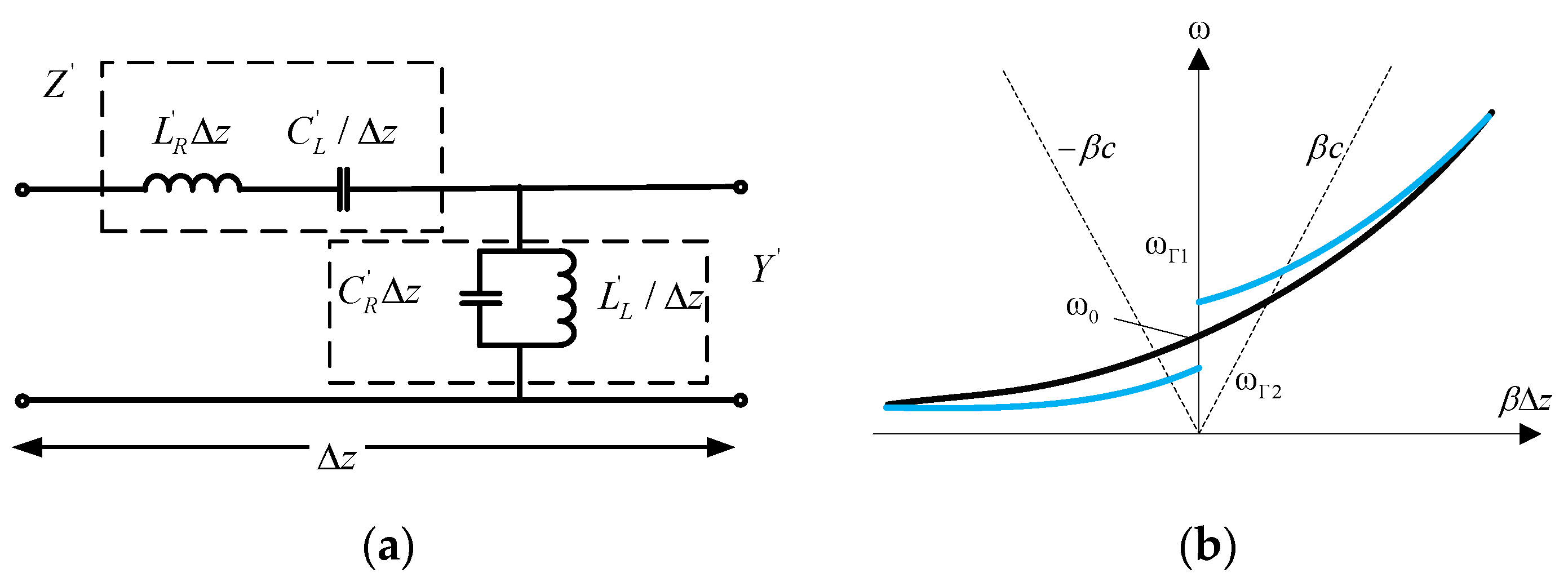


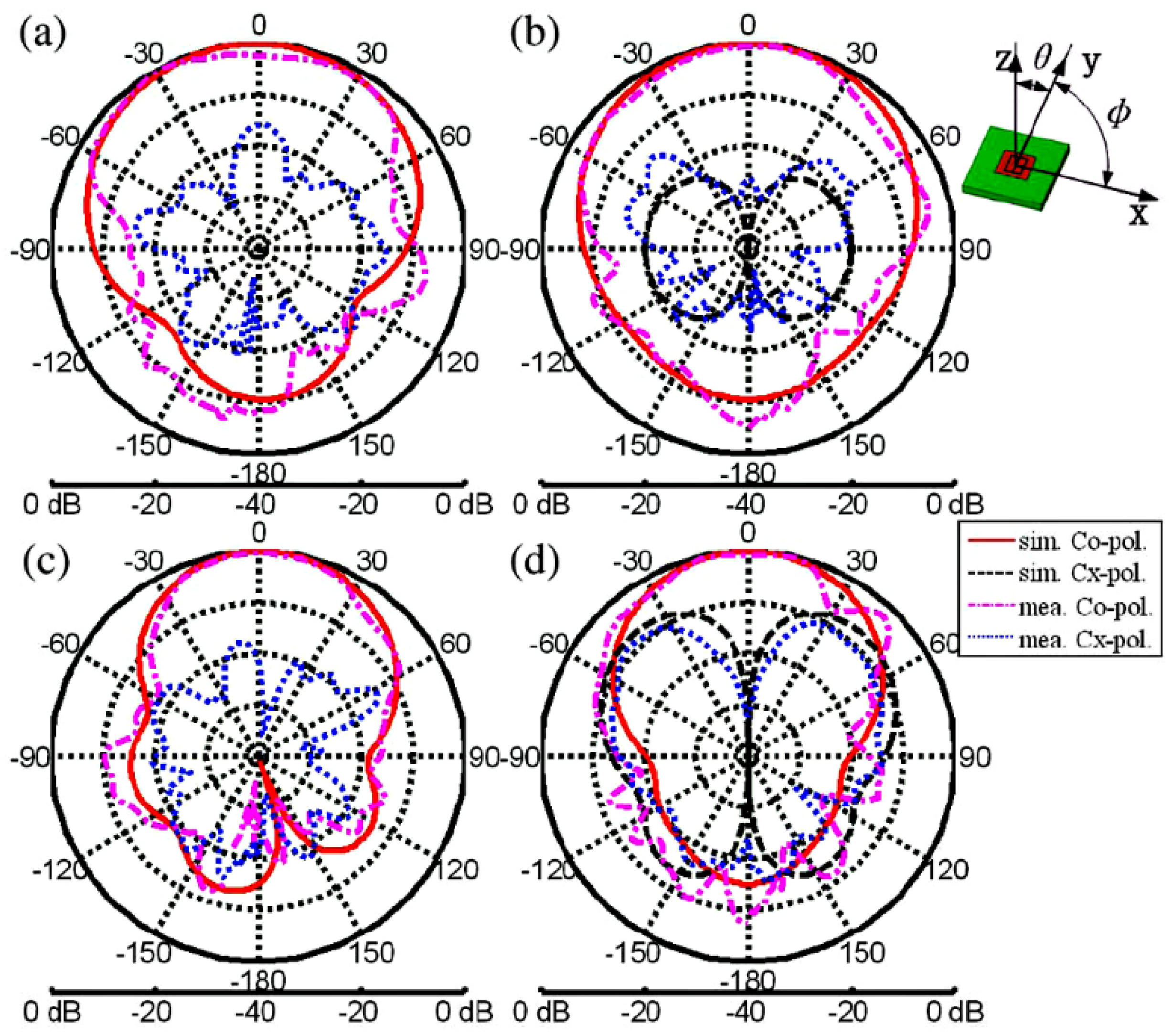



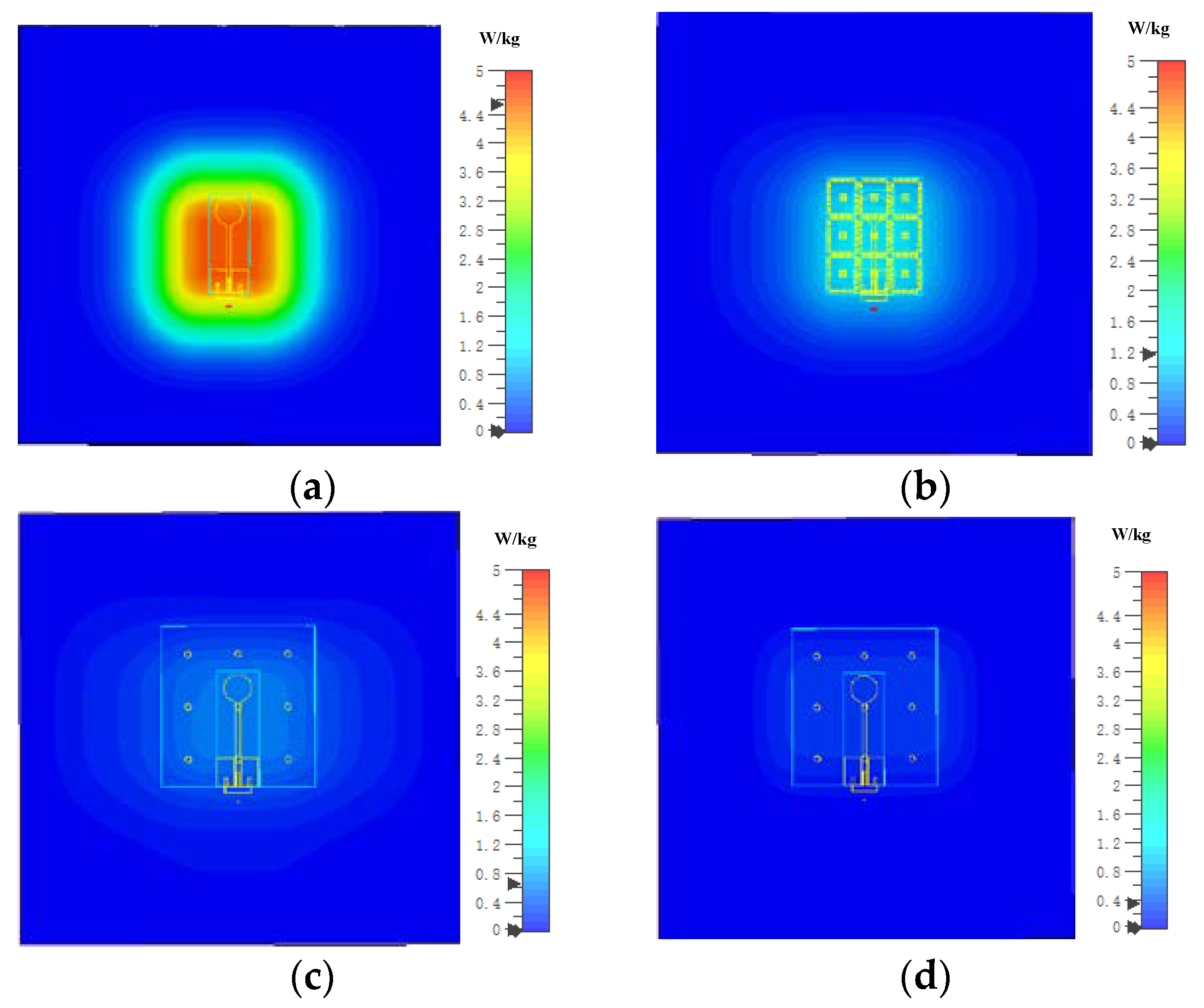

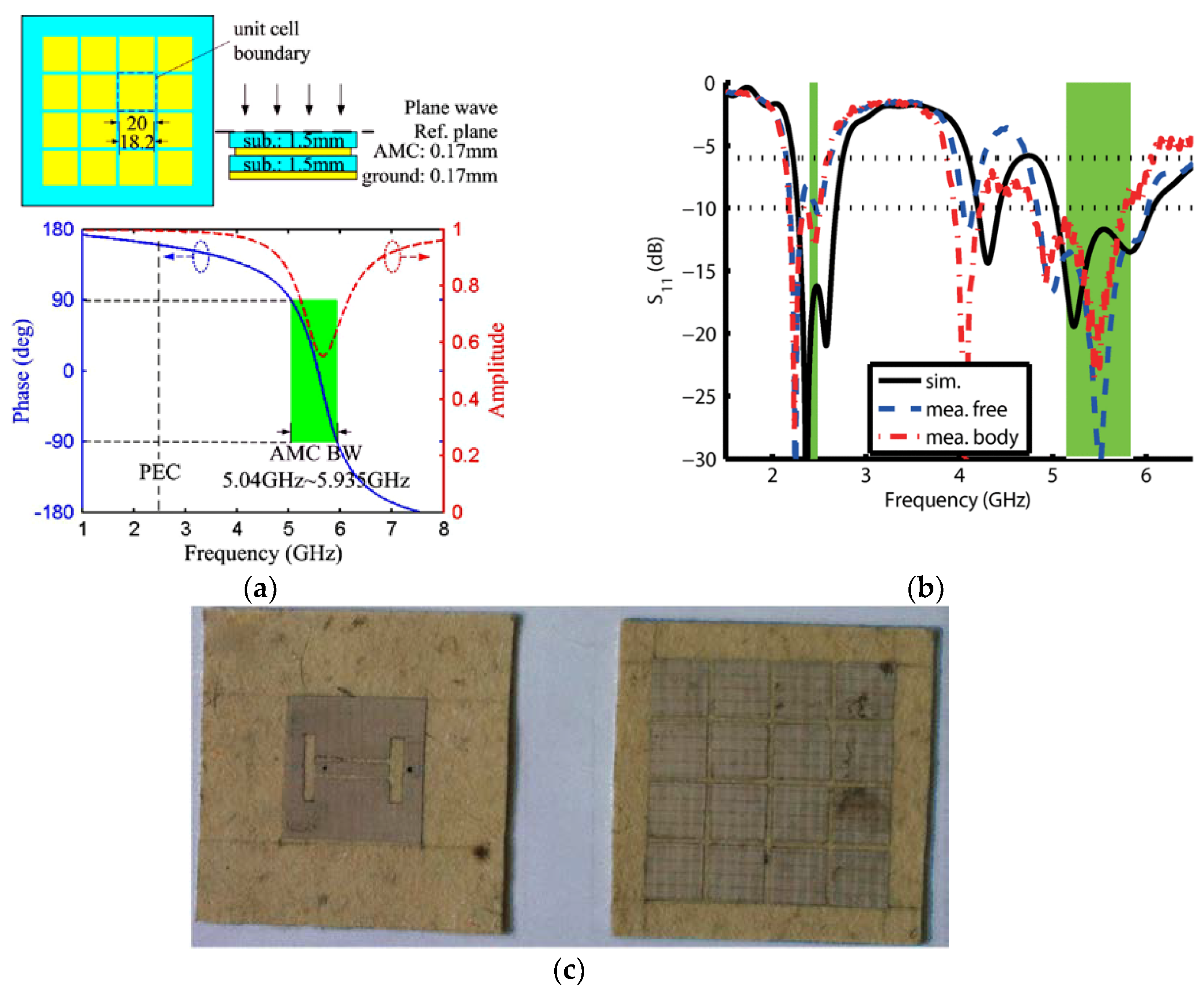
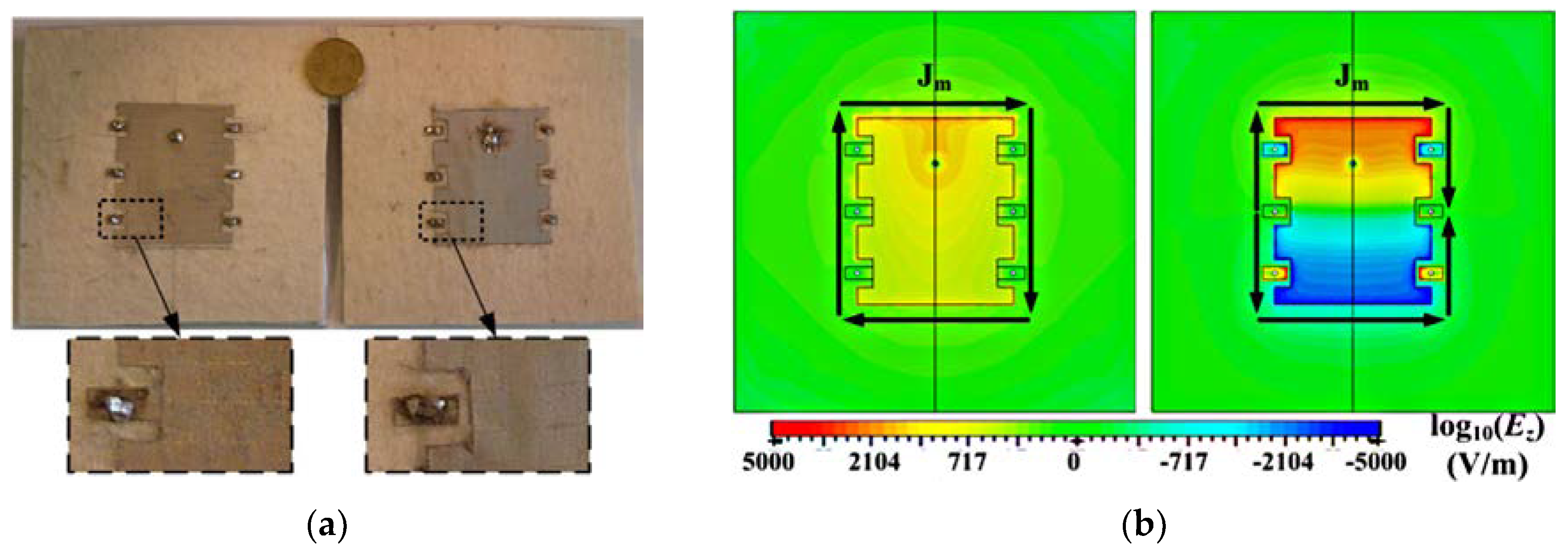
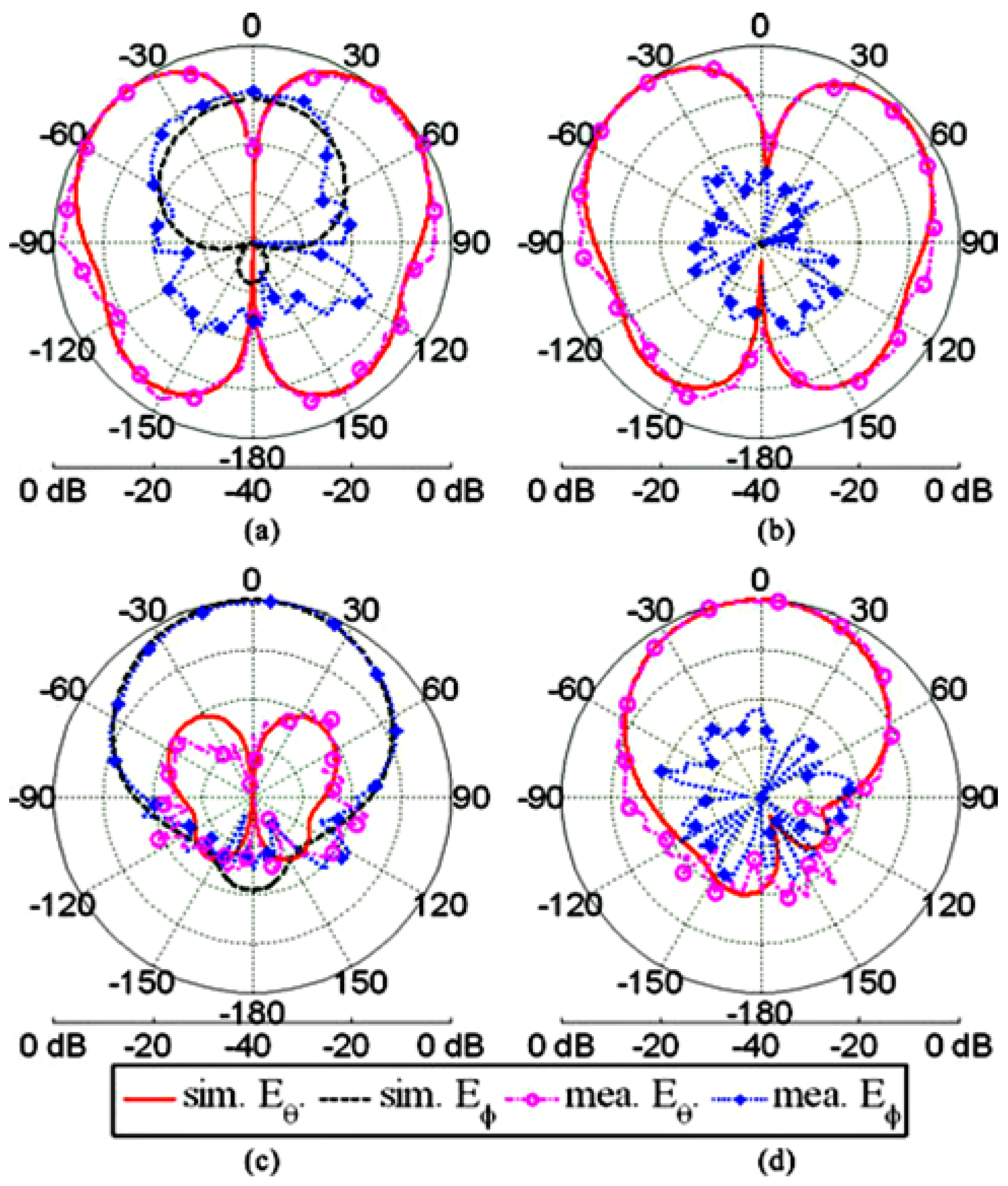
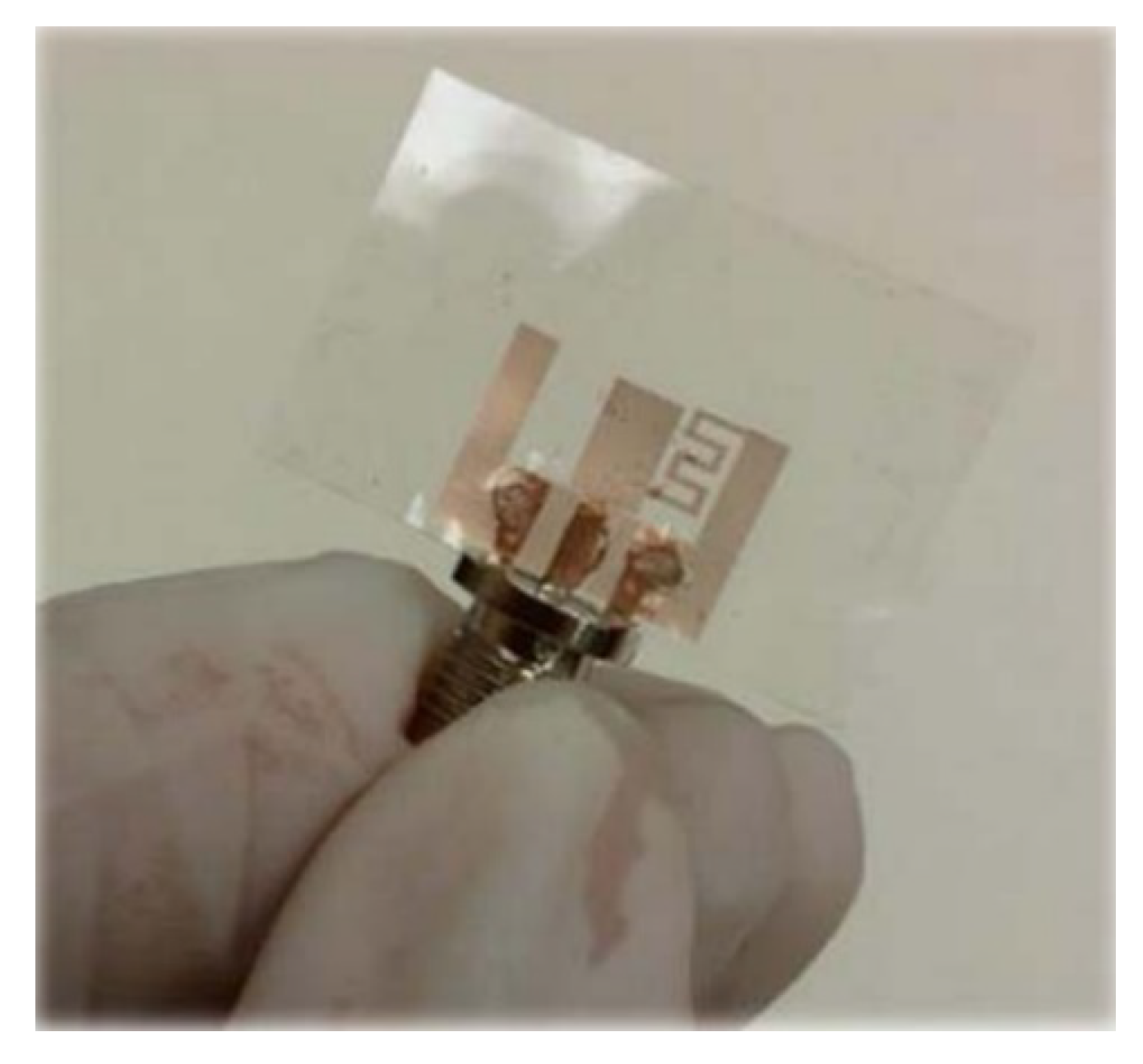
| Ref. | Frequency (GHz) | Bandwidth | Gain (dBi) | Size (λ2) | SAR (W/kg) | Substrate (εr) |
|---|---|---|---|---|---|---|
| [53] | 0.88/1.9 | 16%/29% | 0.06/2.2 | * 0.08(@0.88) | - | Substrate (2.41) |
| [57] | 2.45/5.2 | 5.5%/11.2% | −3.5/6.6 | 0.16(@2.45) | 0.012/0.25 | Felt substrate (1.3) |
| [58] | 2.45/5.4 | 3.8%/7.6% | −1.37/4.68 | 0.39(@2.45) | Felt substrate (1.3) | |
| [77] | 2.4 | - | −5.2 | 0.01 | - | RT/Duroid 5880 (2.2) |
| [78] | 2.4 | 3% | - | 0.04 | - | Substrate (2.2) |
| [79] | 2.4 | 6.5% | 1.39 | 0.1 | - | Rodgers RO 3003 (3.0) |
| [80] | 2.4 | 2.5% | −7 | - | - | RT/Duroid 5880 (2.2) |
| Ref. | Frequency (GHz) | Bandwidth | Gain (dBi) | Size (λ2) | SAR (W/kg) | Substrate (εr) |
|---|---|---|---|---|---|---|
| [5] | 2.65 | * 8.6% (@2.3) ** 11.5% (@2.65) | 1.3 2.99 | 0.048 0.1 | 4.5 1.25 | Substrate (2.65) |
| 2.45/3.65 | 13.6% (@2.2) 15.7%/2.3% | - 4.25/7.35 | 0.036 (@2.45) 0.2 (@2.45) | - 0.65/0.37 | Substrate (2.65) | |
| [61] | 2.45 | 12% 18% | 1.1 4.8 | 0.09 0.28 | 1.88 0.638 | Kapton polyimide (3.5) |
| [62] | 2.4 | 15% 27% | - 7.8 | 0.04 0.14 | 2.7 0.0138 | Substrate (1.7) |
| [63] | 2.4 | 14.5% 1.38% | 3.41 8.53 | 1.22 | 8.85 0.69 | Polyester (2.8) |
| [64] | 2.45 | - 4.88% | - 6.88 | 0.17 | - 0.244 | RT/duroid 5880 (2.2) |
| [65] | 2.45 | 44.8% 25% | 5.15 6.38 | 0.21 0.38 | 1.52 0.0072 | Rogers 3850 (2.9) |
| [74] | 2.45 | - 3.6% | 4.2 | 0.05 | - 0.55 | FR-4 (4.3) |
| [75] | 5.5 | - 15.8% | - 7.63 | - 0.25 | 0.198 | Substrate (2.7) |
| [76] | 2.45 | 24% 16.3% | 4.37 7.7 | 0.11 0.54 | 2.71 0.04 | Substrate (1.6) |
| [83] | 5.8 | 11% (@6.2) 10.7% (@5.8) | −3.83 −0.75 | 0.15 3.84 | 1.22 0.31 | Leather substrate (2.3) |
| [84] | 3.5/5.7/10/14 | 153% (2.1–16) 149% (2.3–16) | 4.3 7.2 | 0.29 (@3.5) | - 0.1 | FR-4 (4.3) |
| [85] | 2.45 | 81% 16.3% | 2.45 8.41 | 1.2 1.02 | 9.39 0.166 | RO3003 (3.0) |
| [86] | 1.97 | 2% 2% | 2.8 4.6 | 0.006 0.05 | 1.4 0.7 | Antenna (3.5) AMC (10.2) |
| [87] | 2.45 | 0% 5% | 4.17 2.32 | 0.16 | 4.2 0.714 | Styrofoam (1) |
| [88] | 20–40 | 61% (20–37.52) 64.4% (20.52–40) | 7.4 10.3 | 2.5 (@28) 9.6 (@28) | - - | Substrate (2.2) |
| [89] | 5.7–11 | 78% (5.25–12) 63% (5.7–11) | 3.5 7.5 | 0.48 (@8) 1.28 (@8) | - - | Panasonic R-F770 (-) |
| [90] | 2.5 | 42% 52% | 0 3.38 | 1.38 | - 0.025 | Felt substrate (1.44) |
| [93] | 2.45 | 8% 10% | −8.2 0.86 | - 1.3 | - - | Photo paper (-) |
| [94] | 2.45 | 4.7% 5.5% | 2.0 6.2 | 0.078 0.15 | 11.3 0.48 | Rogers. RO3003 (3) |
| [95] | 5.5 | 20% (5.5–6.75) 17% | 5.2 6.7 | 0.38 | - 0.43 | Wool felt (1.2) |
| [96] | 2.45/5.8 | 32%/25.8% 8%/27.5% | 1.97/4.2 6.3/6.7 | 0.078 (@2.45) 0.25 (@2.45) | 21.41/7.57 0.414/0.9 | Felt substrate (1.22) |
| [97] | 2.5/5.5 | 12%/41% 56%/32% | - | 0.14 (@2.5) 0.50 (@2.5) | - | Felt substrate (1.22) |
| [99] | 2.45/5.5 | 17%/16% 4%/12% | 3.9/5.2 6.4/7.6 | 0.20 (@2.45) 0.96 (@2.45) | 7.819/6.808 0.043/0.097 | Felt substrate (1.38) |
| [101] | 1.575/2.45 | - 7.6%/5.5% | - 1.98/1.94 | 0.20 (@1.575) | - 0.78/0.71 | Kevlar (1.66) |
| [102] | 2.45/5.5 | - 12%/16.3% | - 2.5/4 | 0.67 (@2.45) | - 0.019/0.009 | Textile (1.3) |
| [103] | 2.45/5.8 | 16.3%/3.4% 8%/6.8% | −4.1/2.33 5.2/7.7 | 0.05 (@2.45) 0.34 (@2.45) | 8.99/4.08 0.7/0.71 | Polyimide (3.5) |
| [104] | 1.8/2.45 | 70% (1.3–2.7) 10.9%/5.08% | - 1–2 | 0.4 (@1.8) 0.81 (@1.8) | 5.77/6.62 0.024/0.016 | Jean (1.7) |
| Ref. | Frequenncy (GHz) | Bandwidth | Gain (dBi) | Size (λ2) | SAR (W/kg) | Substrate (εr) |
|---|---|---|---|---|---|---|
| [105] | 2.4 | 0.086 (State1) 0.055 (State2) | 2.9 4.5 | 0.64 | 0.05 0.01 | Felt substrate (1.3) |
| [106] | 2.92 | 10% (2.64–2.94) | −0.02 | 0.009 | - | Tortuous Cu mesh/PDMS (2.8) |
| [107] | 2.45/3.3 | * - ** 7%/3% | 2.6/0.6 6.2/3.0 | ***0.5 (@2.45) | 2 0.29/- | RO3003 (3) |
Publisher’s Note: MDPI stays neutral with regard to jurisdictional claims in published maps and institutional affiliations. |
© 2020 by the authors. Licensee MDPI, Basel, Switzerland. This article is an open access article distributed under the terms and conditions of the Creative Commons Attribution (CC BY) license (http://creativecommons.org/licenses/by/4.0/).
Share and Cite
Zhang, K.; Soh, P.J.; Yan, S. Meta-Wearable Antennas—A Review of Metamaterial Based Antennas in Wireless Body Area Networks. Materials 2021, 14, 149. https://doi.org/10.3390/ma14010149
Zhang K, Soh PJ, Yan S. Meta-Wearable Antennas—A Review of Metamaterial Based Antennas in Wireless Body Area Networks. Materials. 2021; 14(1):149. https://doi.org/10.3390/ma14010149
Chicago/Turabian StyleZhang, Kai, Ping Jack Soh, and Sen Yan. 2021. "Meta-Wearable Antennas—A Review of Metamaterial Based Antennas in Wireless Body Area Networks" Materials 14, no. 1: 149. https://doi.org/10.3390/ma14010149





